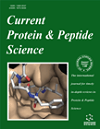- Home
- A-Z Publications
- Current Protein and Peptide Science
- Previous Issues
- Volume 24, Issue 2, 2023
Current Protein and Peptide Science - Volume 24, Issue 2, 2023
Volume 24, Issue 2, 2023
-
-
Protein Engineering Strategies for Tailoring the Physical and Catalytic Properties of Enzymes for Defined Industrial Applications
More LessAuthors: Rakesh Kumar, Arbind Kumar and Jagdeep KaurBackground: Highly evolved biocatalysts that can endure harsh environmental conditions during industrial processes are highly desirable. The availability of suitable biocatalysts with high enzyme activity, substrate selectivity, and stability could lower the production costs in the pharmaceutical, chemical, and food industries, resulting in more economical products. Objectives: Naturally evolved enzymes could not Read More
-
-
-
Circular RNAs: Insights into Clinical and Therapeutic Approaches for Various Cancers
More LessAuthors: Ikram u. Haq, Fatima Akram, Narmeen Nasir and Fatima Iftikhar ShahBackground: With the advent of cancer diagnostics and therapeutics, circular RNAs (circRNAs) are swiftly becoming one of the significant regulators of gene expression and cellular functions. A plethora of multiple molecular mechanisms has been observed to elicit their influence. Objective: Circular RNAs (circRNAs) are a distinct category of endogenous noncoding RNAs designed as a result of exon back splicing events in pre Read More
-
-
-
The Roles of IGF-1 and MGF on Nerve Regeneration under Hypoxia- Ischemia, Inflammation, Oxidative Stress, and Physical Trauma
More LessAuthors: Yongqiang Sha, Liping Chen, Chunming Xu, Beibei Zhang, Huhai Hong and Chunli WangNerve injuries and lesions often lead to the loss of neural control, reducing the patients’ quality of lives. Nerve self-repair is difficult due to the low regeneration capacity, insufficient secretion of neurotrophic factors, secondary complications, and adverse microenvironmental conditions such as severe hypoxia-ischemia, inflammation, and oxidative stress. Effective therapies that can accelerate nerve regeneration have been expl Read More
-
-
-
Anti-microbial Peptides against Methicillin-resistant Staphylococcus aureus: Promising Therapeutics
More LessBackground: Multidrug-resistant (MDR) methicillin-resistant Staphylococcus aureus (MRSA) has become a prime health concern globally. These bacteria are found in hospital areas where they are regularly dealing with antibiotics. This brings many possibilities for its mutation, so drug resistance occurs. Introduction: Nowadays, these nosocomial MRSA strains spread into the community and live stocks. Resistance in Sta Read More
-
-
-
PAK1 Inhibition Suppresses the Proliferation, Migration and Invasion of Glioma Cells
More LessAuthors: Qinghao Yi, Tianze Chen, Kunlin Zhou, Qiang Ma, Zhiyuan Sun and Hengliang ShiBackground: p21-activated kinase 1 (PAK1) is abnormally expressed in glioma, but its roles and mechanisms in glioma remain unclear. This study aims to explore the effects of PAK1 inhibition on the proliferation, migration and invasion of glioma cells. Methods: Cell Counting Kit-8 (CCK-8), 5128;ethynyl128;20128;deoxyuridine (EdU) incorporation and colony formation assays were performed to evaluate the effects of PAK1 i Read More
-
-
-
Effectiveness of HM-3-HSA on Inhibiting Cancer Cell Migration and Metastasis
More LessAuthors: Ting Li, Ruyue Wang, Kaike Li, Peiya Wang, Jiang Zhao, Qi Guo, Jun Zhang, Yang Li, Hongyu Li and Hui YangBackground: Metastasis is the major cause of treatment failure in cancer patients and cancer- associated death, and an antimetastatic drug would be a beneficial therapy for cancer patients. HM-3-HSA is a fusion protein which improved the pharmacokinetics of HM-3 and exerted antitumor and anti-angiogenesis activity in multiple tumor models. However, the efficacy of HM-3-HSA in cancer cell migration and metastasis has not Read More
-
Volumes & issues
-
Volume 26 (2025)
-
Volume 25 (2024)
-
Volume 24 (2023)
-
Volume 23 (2022)
-
Volume 22 (2021)
-
Volume 21 (2020)
-
Volume 20 (2019)
-
Volume 19 (2018)
-
Volume 18 (2017)
-
Volume 17 (2016)
-
Volume 16 (2015)
-
Volume 15 (2014)
-
Volume 14 (2013)
-
Volume 13 (2012)
-
Volume 12 (2011)
-
Volume 11 (2010)
-
Volume 10 (2009)
-
Volume 9 (2008)
-
Volume 8 (2007)
-
Volume 7 (2006)
-
Volume 6 (2005)
-
Volume 5 (2004)
-
Volume 4 (2003)
-
Volume 3 (2002)
-
Volume 2 (2001)
-
Volume 1 (2000)
Most Read This Month
Article
content/journals/cpps
Journal
10
5
false
en


